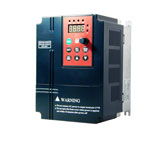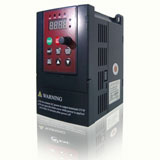VFD in Central Air-conditioning System
As the rapid development of China economy and the improvement of Chinese people's standard of living, the central air-conditioning system has become popular in the inns, hotels, office buildings, supermarkets, hospitals, factories, etc.
The central air-conditioning system mainly consists of refrigeration compressor group, cooling (heat) medium circulating water system, cooling circulating water system, cooling tower fan and coil pipe fan. However, all the central air-conditioning systems currently have a same burning weakness that is it is hard to control their output temperature according to seasons, day and night, and the amount of the people. Although having adopted the valve adjustment mode, yet a mass of energy has been wasted since its motor is always working at full speed. Statistics show that in the office buildings, about 60% energy of the total is consumed by the central air-conditioning system.
Central air-conditioning system working principle
The central air-conditioning system can be classified as constant torque load and square torque load by the load type.
Constant torque load: the screw- or centrifugal- refrigeration compressor is of the constant torque load, which always need limit the min. axis output torque, and the relationship between its speed and power approaches linearity.
Square torque load: such as cooling (heat) medium circulating water system, cooling circulating water system, cooling tower fan and coil pipe fan, which have no particular requirements to the axis torque, and the axis power is proportional to the cube of the speed.
As the refrigeration compressor inside the central air-conditioning system has already had automatic regulation function, the energy saving reconstruction should focus on the pumps and fans. From the theory of fluid mechanics, the output flow quantity (Q) of the centrifugal pump or fan is proportional to its speed (n); the output pressure (P) is proportional to the square of the speed (n); while the output power (N) is proportional to the cube of the speed (n), as shown below:
Cooling water system Closed-loop control
The standard circulating water temperature of the central air-conditioning system is 12℃(intake) / 7℃(outlet), with allowable temperature difference of 5℃. If the temperature difference between the intake and outlet is 2℃, it indicates that the actual demand is just 40% of the supply (2℃/5℃=40%). Thus, if frequency conversion speed control is available at this time, it can adjust the speed of the pump to 40% of its rates speed, which can meet cooling requirements but also can save a lot of energy.
Control proposal: Firstly, confirm the minimum operating frequency of the variable frequency drive (commonly as 25HZ), and set the value as the lower bound of the frequency, so as to fix on the minimum speed of the pump, and then detect the temperature difference between the intake and outlet through an intelligent temperature controller, so as to control the increment and decrement of the VFD frequency.
Cooling water pump Closed-loop control (in the heating mode)
This mode is selected in falls for heating. The control proposal is same as above.
Cooling circulating water pump Open-loop control
The standard cooling circulating water temperature difference of the central air-conditioning system is 4℃~8℃,and that of the cooling tower is 3℃~5℃. In the heating mode, the intake water temperature and outlet water temperature are 50℃ and 60℃ respectively. Since the cooling water circulating system is affected simultaneously by the ambient temperature and thermal load, the temperature sensor need be added on the main intake pipeline and also on the main outlet pipeline. On condition of ambient temperature constant, if the temperature difference is huge, it indicates the thermal load inside is too large. So we should increase the speed of the cooling pump. Conversely, if the temperature difference is small, we should decrease the pump speed.
Coil pipe fan system control
Each room has a coil pipe fan. Its motor is 0.4KW 220V, with the maximum temperature difference of the wind is 10℃~15℃. The coil pipe fan system, with water and air as its load thermal interface material, is mainly responsible for air change, so as to improve comfort inside the room.
After reconstruction with the frequency conversion technology, the fan can maintain the inside temperature constantly at 17℃±1℃, with energy saving rate up to 80%. In addition, the noise can be dramatically reduced by the VFD.
Cooling tower fan system
The cooling tower fan system commonly contains two fans. Before reconstruction, the fans only have two modes: run at full speed and manual stop, which causes a mass of energy to be wasted. When reconstruction, the start temperature of the cooling tower fan is set as 35℃, and the stop temperature is set as 30℃. And in the range of 35℃~30℃, the users can realize PID closed-loop control to adjust the wind volume. Field operation shows average power saving rate hits 40%.
Conclusion
It is a significant step in China energy saving campaign to apply the frequency conversion technology into the central air-conditioning system. Statistics show that at least 70% of China's central air-conditioning systems haven't had any energy saving function to date, which indicates a huge market for the VFD manufacturers.
The central air-conditioning system mainly consists of refrigeration compressor group, cooling (heat) medium circulating water system, cooling circulating water system, cooling tower fan and coil pipe fan. However, all the central air-conditioning systems currently have a same burning weakness that is it is hard to control their output temperature according to seasons, day and night, and the amount of the people. Although having adopted the valve adjustment mode, yet a mass of energy has been wasted since its motor is always working at full speed. Statistics show that in the office buildings, about 60% energy of the total is consumed by the central air-conditioning system.
Central air-conditioning system working principle
The central air-conditioning system can be classified as constant torque load and square torque load by the load type.
Constant torque load: the screw- or centrifugal- refrigeration compressor is of the constant torque load, which always need limit the min. axis output torque, and the relationship between its speed and power approaches linearity.
Square torque load: such as cooling (heat) medium circulating water system, cooling circulating water system, cooling tower fan and coil pipe fan, which have no particular requirements to the axis torque, and the axis power is proportional to the cube of the speed.
As the refrigeration compressor inside the central air-conditioning system has already had automatic regulation function, the energy saving reconstruction should focus on the pumps and fans. From the theory of fluid mechanics, the output flow quantity (Q) of the centrifugal pump or fan is proportional to its speed (n); the output pressure (P) is proportional to the square of the speed (n); while the output power (N) is proportional to the cube of the speed (n), as shown below:
- Q ∝ n
- P ∝ n2
- N ∝ n3
Cooling water system Closed-loop control
The standard circulating water temperature of the central air-conditioning system is 12℃(intake) / 7℃(outlet), with allowable temperature difference of 5℃. If the temperature difference between the intake and outlet is 2℃, it indicates that the actual demand is just 40% of the supply (2℃/5℃=40%). Thus, if frequency conversion speed control is available at this time, it can adjust the speed of the pump to 40% of its rates speed, which can meet cooling requirements but also can save a lot of energy.
Control proposal: Firstly, confirm the minimum operating frequency of the variable frequency drive (commonly as 25HZ), and set the value as the lower bound of the frequency, so as to fix on the minimum speed of the pump, and then detect the temperature difference between the intake and outlet through an intelligent temperature controller, so as to control the increment and decrement of the VFD frequency.
Cooling water pump Closed-loop control (in the heating mode)
This mode is selected in falls for heating. The control proposal is same as above.
Cooling circulating water pump Open-loop control
The standard cooling circulating water temperature difference of the central air-conditioning system is 4℃~8℃,and that of the cooling tower is 3℃~5℃. In the heating mode, the intake water temperature and outlet water temperature are 50℃ and 60℃ respectively. Since the cooling water circulating system is affected simultaneously by the ambient temperature and thermal load, the temperature sensor need be added on the main intake pipeline and also on the main outlet pipeline. On condition of ambient temperature constant, if the temperature difference is huge, it indicates the thermal load inside is too large. So we should increase the speed of the cooling pump. Conversely, if the temperature difference is small, we should decrease the pump speed.
Coil pipe fan system control
Each room has a coil pipe fan. Its motor is 0.4KW 220V, with the maximum temperature difference of the wind is 10℃~15℃. The coil pipe fan system, with water and air as its load thermal interface material, is mainly responsible for air change, so as to improve comfort inside the room.
After reconstruction with the frequency conversion technology, the fan can maintain the inside temperature constantly at 17℃±1℃, with energy saving rate up to 80%. In addition, the noise can be dramatically reduced by the VFD.
Cooling tower fan system
The cooling tower fan system commonly contains two fans. Before reconstruction, the fans only have two modes: run at full speed and manual stop, which causes a mass of energy to be wasted. When reconstruction, the start temperature of the cooling tower fan is set as 35℃, and the stop temperature is set as 30℃. And in the range of 35℃~30℃, the users can realize PID closed-loop control to adjust the wind volume. Field operation shows average power saving rate hits 40%.
Conclusion
It is a significant step in China energy saving campaign to apply the frequency conversion technology into the central air-conditioning system. Statistics show that at least 70% of China's central air-conditioning systems haven't had any energy saving function to date, which indicates a huge market for the VFD manufacturers.



